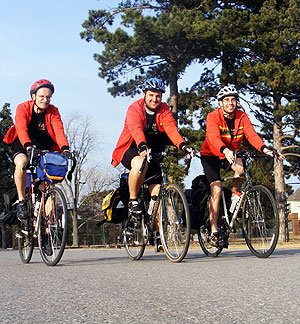 |
| Steve Taylor, a family doctor, Brett Taylorand Duane Vaughan are embarking on a 10,000-kilometre journey topromote the benefits of exercise in preventing and minimizingdisability and death from cardiovascular disease. |
Brett Taylor is taking the long cut to HÂş»âa10,000-kilometre route that goes first to Vancouver, then acrosscentral Canada, through Ontario, to Quebec and then the Maritimes.And, after that, heâll take the ferry to Newfoundland beforelooping back to Halifax.
âWeâre going to the extreme,â admits Mr.Taylor, who is cycling across the country this summer with hisroommate Duane Vaughan and his father Steve Taylor. âButbreaking out of the sedentary lifestyle is really easy todo.â
Having just finished a masterâs degree in history atMcMaster University in Hamilton, Ont., he knows all about asedentary lifestyle. During crunch time, the biggest workout a lotof students get is to and from the library.
The cross-Canada tour should bring him to Dalâs door justin time for the fall term; heâs been accepted toHÂş»âs Masters of Public Administration/Bachelor of Laws(MPA/LLB) program. By covering 100 kilometres a day, he expects hisjourney should take four months to complete, from May to the end ofAugust.
Once the trio decided this is how theyâd spend the summer,they decided to hook up with the Heart & Stroke Foundation inorder to promote the benefits of exercise in preventing andminimizing disability and death from cardiovascular disease.
âFor a sedentary person to get more active, it has theimpact of a smoker quitting smoking. Itâs huge,â saysMr. Taylor. âAnd itâs fairly easy to do; just a fewhours spread over a week makes a huge difference. Something assilly as getting off the bus two stops early or taking the stairsor walking to the grocery store instead of driving. All that stuffadds up fast.â
It's a matter of health
Research indicates Canadians are unaware that physicalinactivity is a serious risk factor for premature death, chronicdisease and disability. Almost half of Canadians (48 per cent) areinactive, which is a serious threat to their health and a burden onthe public health care system.
Moreover, 91 per cent of Canadian children and youth are notmeeting the guidelines of Canadaâs Physical Activity Guidesfor Children and Youth, which state that children should beaccumulating 90 minutes per day of moderate to vigorous physicalactivity in addition to incidental activities required for dailyliving. And yet, each weekday, Canadian children and youth areaveraging five to six hours of screen time, in front of a TV set orvideo-game console. In addition, between 1978 and 2004, the numberof overweight Canadian children doubled and, during the sameperiod, the incidence of obesity has tripled in both boys andgirls.
Their has all kinds of ideas for working activityinto your day and invites people to take an active-living pledge,from ârunning after the grandkidsâ to rollerblading towork.
Exercise is fun
âYou hear the word âexerciseâ and your mindautomatically thinks âgoing to a gym and running on atreadmill,ââ says Mr. Taylor, 24. âBut exercisedoesnât have to be workâyou can play squash, kickaround a soccer ball, get out and play pond hockey. Do somethingneat and different.â
The three cyclists have been training hard for their journey,although Mr. Taylor has a pretty good idea of what to expect,having cycled 3,000 kilometres between Germany and Romania in thesummer between his bachelor and masterâs degrees.
âItâs a really great way to travel because you seeso much more than you would even in a car,â he says.âPlus, you stop; you meet people; you talk to people. When Ifinished, I thought I actually donât know my own country thatwell, and thatâs when this plan took shape.â
Theyâll be documenting their journey on their website andtaking pledges for the Heart & Stroke Foundation. For moreinfo, check out: .
